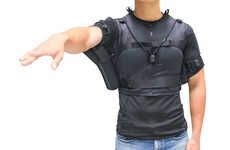
The Pentagon's Fiber Optic Arm is Being Fitted to Amputated Veterans
Omar Yusuf — November 6, 2011 — Tech
References: gizmodo
When an American soldier is wounded in the process of serving his country, the Pentagon and armed services have a tendency of throwing their full weight behind his recovery, and the Fiber Optic Arm hopes to give the most maimed and impaired veterans a chance at recovery.
According to a military-funded team of researchers at the Southern Methodist University, the best chance of giving prosthetics a degree of verisimilitude is with laser beams. A bundle of laser-filled fibers will be the intermediary between the next generation of prosthetic hands and the severed limbs they've been attached to. The Fiber Optic Arm can successfully translate the minute nerve impulses the body produces to tell limbs when and how to move, and will deliver those messages to a robotic hand. With tests being conducted as we speak, the next stage will be to send those neural messages back to the brain, so that the arm will be able to detect heat, pain and pressure.
Here's hoping the soldiers who served without question will have the pleasure of fully functional limbs as soon as possible.
According to a military-funded team of researchers at the Southern Methodist University, the best chance of giving prosthetics a degree of verisimilitude is with laser beams. A bundle of laser-filled fibers will be the intermediary between the next generation of prosthetic hands and the severed limbs they've been attached to. The Fiber Optic Arm can successfully translate the minute nerve impulses the body produces to tell limbs when and how to move, and will deliver those messages to a robotic hand. With tests being conducted as we speak, the next stage will be to send those neural messages back to the brain, so that the arm will be able to detect heat, pain and pressure.
Here's hoping the soldiers who served without question will have the pleasure of fully functional limbs as soon as possible.
Trend Themes
1. Laser-powered Prosthetics - Using laser beams as an intermediary for the next generation of prosthetic hands.
2. Fiber Optic Arm - Developing a prosthetic arm that can successfully translate nerve impulses and deliver them to a robotic hand.
3. Neural Message Transmission - Sending neural messages back to the brain to enable the arm to detect heat, pain, and pressure.
Industry Implications
1. Medical Technology - Applying laser technology to enhance the functionality and realism of prosthetics.
2. Robotics - Incorporating advanced robotics in the field of prosthetic limbs.
3. Military and Defense - Using innovative techniques to improve the quality of life for injured veterans.
1.3
Score
Popularity
Activity
Freshness























